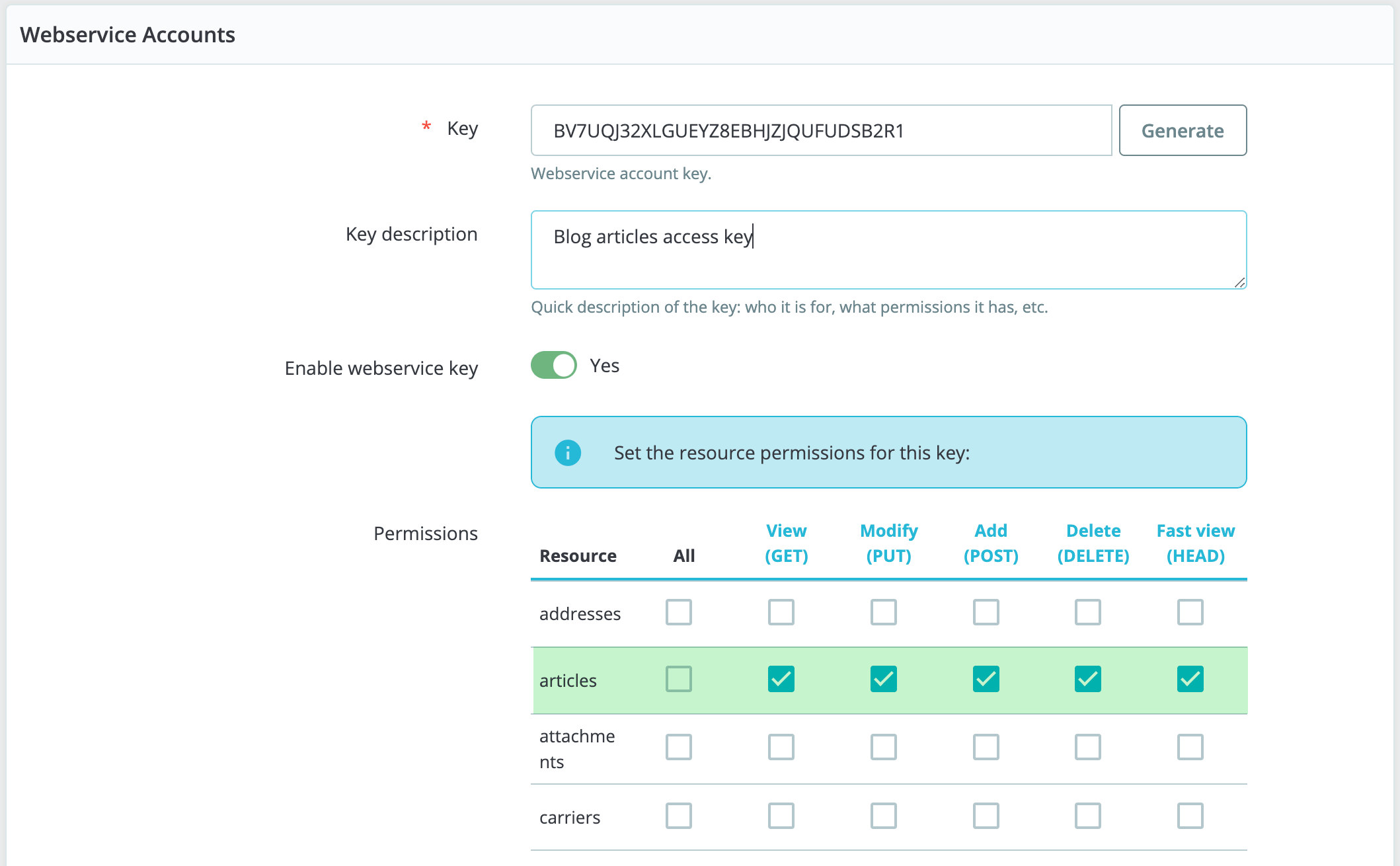Warning: You are browsing the documentation for PrestaShop 8, which is outdated.
You might want to read an updated version of this page for the current version, PrestaShop 9. Read the updated version of this page
Extend Webservice with a custom resource
PrestaShop enables merchants to give third-party tools access to their shop’s database through a CRUD API, otherwise called a web service.
Since 1.7 version, developers can extend the resources available through the PrestaShop Webservice with a module.
More informations about PrestaShop Webservice API here.
Create and declare the new entity
The following example is about an entity that can manage blog articles, the folder where you create your Entity is not relevant.
PS: Remember to create the respective table(s) in the database, usually created during the module installation.
<?php
// modules/yourmodule/src/Entity/Article.php
class Article extends ObjectModel
{
public $title;
public $type;
public $content;
public $meta_title;
public $date_add;
public $date_upd;
/**
* @see ObjectModel::$definition
*/
public static $definition = array(
'table' => 'article',
'primary' => 'id_article',
'multilang' => true,
'fields' => array(
'type' => array('type' => self::TYPE_STRING, 'validate' => 'isCleanHtml', 'required' => true, 'size' => 255),
'date_add' => ['type' => self::TYPE_DATE, 'validate' => 'isDate'],
'date_upd' => ['type' => self::TYPE_DATE, 'validate' => 'isDate'],
// Lang fields
'title' => array('type' => self::TYPE_STRING, 'validate' => 'isCleanHtml', 'required' => true, 'size' => 255),
'content' => array('type' => self::TYPE_HTML, 'lang' => true, 'validate' => 'isCleanHtml', 'size' => 4000),
'meta_title' => array('type' => self::TYPE_STRING, 'lang' => true, 'validate' => 'isCleanHtml', 'size' => 255)
)
);
protected $webserviceParameters = array(
'objectNodeName' => 'article',
'objectsNodeName' => 'articles',
'fields' => array(
'title' => array('required' => true),
'type' => array('required' => true),
'content' => array(),
'meta_title' => array(),
)
);
}
The $webserviceParameters array is mandatory to define how and which fields to expose.
The key to access all the elements:
'objectsNodeName' => 'articles'
The key to access a single element:
'objectNodeName' => 'articles'
The parameter to set which fields to expose through the webservice and settings for each of them:
'fields' => array()
Register the hook
The hook addWebserviceResources must be registered and implemented by the module.
public function hookAddWebserviceResources($params)
{
return [
'articles' => [
'description' => 'Blog articles', // The description for those who access to this resource through WS
'class' => 'Article', // The classname of your Entity
'forbidden_method' => array('DELETE') // Optional, if you want to forbid some methods
]
];
}
Load the entity
Don’t forget to include the class file of the entity (e.g., Article.php) at the top of the main module file (unless you use a composer-based module with namespaces). The following is an example of a correct configuration to load the example entity in the module.
require_once _PS_MODULE_DIR_ . 'wsarticle/src/Entity/Article.php';
Complete example of a main module file
<?php
if (!defined('_PS_VERSION_')) {
exit;
}
require_once _PS_MODULE_DIR_ . 'wsarticle/src/Entity/Article.php';
class WsArticle extends Module
{
public function __construct()
{
$this->name = 'wsarticle';
$this->tab = 'front_office_features';
$this->version = '1.0.0';
$this->author = 'PrestaShop';
$this->need_instance = 0;
$this->secure_key = Tools::encrypt($this->name);
$this->bootstrap = true;
parent::__construct();
$this->displayName = $this->getTranslator()->trans('Extend WS demo module', array(), 'Modules.Wsarticle.Admin');
}
public function install()
{
return parent::install() &&
$this->installDB() && // Create tables in the DB
$this->registerHook('addWebserviceResources'); // Register the module to the hook
}
public function installDB()
{
$sql = 'CREATE TABLE IF NOT EXISTS `'._DB_PREFIX_.Article::$definition['table'].'` (
`id_article` int(10) unsigned NOT NULL AUTO_INCREMENT,
`type` varchar(255),
`date_add` datetime NOT NULL,
`date_upd` datetime NOT NULL,
PRIMARY KEY (`id_article`)
) ENGINE='._MYSQL_ENGINE_.' DEFAULT CHARSET=utf8mb4 COLLATE=utf8mb4_general_ci';
$sql_lang = 'CREATE TABLE IF NOT EXISTS `'._DB_PREFIX_.Article::$definition['table'].'_lang` (
`id_article` int(10) unsigned NOT NULL,
`id_lang` int(10) unsigned NOT NULL,
`title` varchar(255),
`content` text NOT NULL,
`meta_title` varchar(255) NOT NULL,
PRIMARY KEY (`id_article`, `id_lang`)
) ENGINE='._MYSQL_ENGINE_.' DEFAULT CHARSET=utf8mb4 COLLATE=utf8mb4_general_ci';
if (Db::getInstance()->execute($sql) && Db::getInstance()->execute($sql_lang)) {
return true;
}
return false;
}
public function hookAddWebserviceResources($params)
{
return [
'articles' => array(
'description' => 'Blog articles', // The description for those who access to this resource through WS
'class' => 'Article', // The classname of your Entity
'forbidden_method' => array('DELETE') // Optional, if you want to forbid some methods
)
];
}
}
Final notes
Following the example above, the new resource will be available in the webservice resources list:

New Webservice resource
This new resource will be accessible through your API endpoint behind the name that you set in objectsNodeName, for instance:
https://mywebsite.shop/api/articles
will return something similar to what you can see on the screenshot below (it is the XML response previewed in the browser):

Webservice articles list (empty)
And something like on the next screenshot, if you have articles in the database:

Webservice articles list (one article)
Download the example module directly
You can find a complete version of this example module here.
Test CRUD actions on the entity with Postman
A Postman collection for this example module is available here.
To use it, please refer to this tutorial